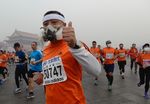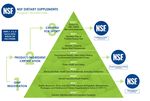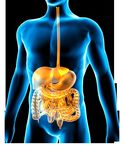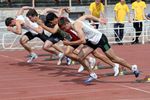Keeping Your Athlete Healthy - Victoria Coleman BSc., D.C., IFMCP, MS (Human Nutrition&Functional Medicine -in progress) - Pro Baseball ...
←
→
Page content transcription
If your browser does not render page correctly, please read the page content below
Keeping Your Athlete
Healthy
Victoria Coleman BSc., D.C., IFMCP, MS (Human
Nutrition&Functional Medicine -in progress)
1Disclosures:
Dr. Victoria Coleman is the VP of Clinical Education for Atrium Innovations, Klean Athlete
is a subsidiary of Atrium Innovations.
The Company assumes no liability for presenter’s information, whether conveyed verbally
or in these materials. All presentations represent the opinions of the presenter and do not
represent the position or the opinion of the Company. Reference by the presenter to any
specific product, process or service by trade name, trademark, or manufacturer does not
constitute or imply endorsement or recommendation by the Company.
Seminars, teleconferences and webinars such as this are for educational purposes only
and are intended for licensed health care practitioners.
These therapies are not substitutions for standard medical care. Practitioners are solely
responsible for the care and treatment provided to their own patients.
2This lecture will cover:
Health not necessarily performance
GI health and Probiotics
Immune health
Vit D
Whey Protein
Sleep
Air pollution
Supplement safety -NSF Certified for Sport®
3What this lecture will NOT cover:
Basic concepts on periodization and fueling
General fuelling of macronutrients
Nutrition for Sport Performance Enhancement
(ergogenic nutrition)
We ARE looking at the bigger picture of health
4Why is this topic important?
“Fit” Athlete Healthy Athlete
Many athletes appear fit for their sport but are not truly
healthy!
5Excessive exercise can:
(>60 minutes)
Oxidative stres ROS, RNS
produce inflammation cytokines
muscle damage and fatigue enzymes of breakdown
lipid peroxidation lipid hydroperoxides
damage to cellular proteins & DNA F2 isoprostanes
depress immune function malonaldehyde
Urinary 8-hydroxy-
deoxyguanosine
WBC
glutathione (GSSG:GSH)
No argument in science these changes occur with excessive endurance exercise
6GI complaints are common amongst
athletes (30%-70%)
Words come in or are in random such as:
GERDS, gastritis, ulcers, Crohns, colonic bleeding,
diarrhea
Waterman J, Kapur R. Upper Gastrointestinal issues in Athletes. Current Sports Medicine Reports:
March/April 2012 - Volume 11 - Issue 2 - p 99–104
8In general: (the obvious)
23 studies, 1917 participants, probiotics with infectious
diarrhea:
reduced risk of diarrhoea
reduced mean duration
Cochrane Database Syst Rev. 2010, Probiotics for treating acute infectious diarrhoea
Meta -analysis of 12 trials
“probiotics reduced the occurrence of traveler’s
diarrhea”
McFarland LV. Meta-analysis of probiotics for the prevention of traveler's diarrhea.
Travel Med Infect Dis 5: 97-105, 2007
9“Probiotics such as Lactobacillus species
have been shown to decrease the
incidence of diarrhea in travellers.
Probiotics are a more natural approach to
prophylaxis of TD. Probiotics colonize the
gastrointestinal tract and theoretically
prevent pathogenic organisms from
infecting the gut”
Boggess, Blake Reid. Gastrointestinal Infections in the Traveling Athlete
Current Sports Medicine Reports Issue: Volume 6(2), April 2007, p 125–129
American College of Sports Medicine
DOI: 10.1097/01.CSMR.0000306453.02069.b3
10What happens to the athletes gut with training?
Gastritis
Ulcerations
GI bleeds
Diarrhea
GERD’s
Ischemic colitis
Intestinal Permeability
11https://thevreelandclinic.wordpress.com/tag/gut-health/
12Contributing Factors:
mechanical forces
altered GI blood flow (reduced splanchnic blood flow)
neuroendocrine changes
temperature extremes (heat)
dehydration
NSAID use
13What happens to the
athlete’s gut with training?
Kim van Wijck, Kaatje Lenaerts, et al.Physiology and pathophysiology of splanchnic hypoperfusion and intestinal injury during exercise:
strategies for evaluation and prevention
American Journal of Physiology - Gastrointestinal and Liver Physiology Published 15 July 2012 Vol. 303 no. 2, G155-G168 DOI: 10.1152/ajpgi.
00066.2012
14In summary with athletes
Intestinal permeability may result from exercise induced
reduction of blood flow and thermal damage to the
intestinal mucosa leading to :
endotoxemia
immune activation
inflammatory response increasing susceptibility to
infectious and autoimmune diseases
Lamprecht et al. Probiotic supplementation affects markers of intestinal
barrier, oxidation, and inflammation in trained men; a randomized, double-
blinded, placebo-controlled trail Journal of the International Society of
Sports Nutrition 2012,9:45
15Probiotic supplementation affects markers of intestinal barrier,
oxidation, and inflammation in trained men; a randomized, double-
blinded, placebo-controlled trail Journal of the International Society of
Sports Nutrition 2012,9:45
RCT STUDY:
23 endurance trained men
30-45 years of age, non smokers
14 weeks consumed a multi-species probiotic (10 billion
CFU)
performed a three part triple step test, total duration 90min
16Outcome measures:
Primary Outcome : probiotics affect on intestinal
permeability
measured Zonulin - surrogate marker of impaired gut
barrier
Secondary Outcome: probiotics affects on oxidative
stress and inflammation
measure: Carbonyl Proteins (CP), Malondialdehyde
(MDA), Total oxidation status (TOS), IL-6, TNFa
17Results:
Primary outcome: Zonulin was reduced to normal
physiologic range in the probiotic group
Note: the athletes all started with a higher than normal
level prior to treatment
Why: the trained cohort already suffered from a mild
increase in intestinal permeability at baseline due to
chronic training
18Take away:
probiotic
supplementation could
be of high practical
relevance for athletes -
improved intestinal
barrier reduces
Take awy: athlete’s susceptibility
to endotoxemia and
associated cytokine
production
(image: entry of luminal antigens with disruption of tight junctions; Suzuki, 2013).
19Secondary Outcomes:
Oxidative stress markers (CP = Carbonyl Proteins)
CP level decreased with probiotics, and post-exercise
increase typically seen, no longer reached significance
20Secondary outcome:
Inflammation
TNFα - pro-inflammatory cytokine, central mediator of
systemic inflammation
exercise challenge did increase TNFα above normal
probiotics reduced values by 20% but not to significance
Note: both groups had significantly increased values of
TNFα at all time points measured (baseline included)
Possible Conclusion: Probiotics reduce this systemic low
grade inflammation indirectly via improved gut barrier
function
21Conclusions: Probiotic supplementation can improve intestinal barrier function, redox hemostatis and low grade inflammation in trained men undergoing sustained exercise stress. Lamprecht et al. Probiotic supplementation affects markers of intestinal barrier, oxidation, and inflammation in trained men; a randomized, double-blinded, placebo-controlled trail Journal of the International Society of Sports Nutrition 2012,9:45 22
Gut Health & NSAIDS
NSAID use is common in athletes and reported to be as high as
90% use in some sports
https://thevreelandclinic.wordpress.com/tag/gut-health/ 23"If I can take 400 mgs of Ibuprofen, and I do that
three times a day so my shoulder doesn't hurt so I
can perform, can I lose sight of what that does
long-term?" Ray asked. "It's kind of natural that
you would do that.” Tracy Ray, Sports Physician
"If I was pitching in three days, I'd take two.
Tomorrow, I'd take four. On game day, I'd take two
in the morning, then two in the afternoon.” Al Leiter,
schedule for taking Advil
Pitchers on anti-inflammatories must beware of liver trouble
Updated May 31, 2010, Newsday
By Ken Davidoff
24Are NSAIDs really a problem?
Aggravation of exercise-induced intestinal injury by
Ibuprofen in athletes.
Aim: assess effect of oral Ibuprofen before exercise
on GI integrity and barrier function in healthy men
Van Wijck K1, Lenaerts K, Van Bijnen AA, Boonen B, Van Loon LJ, Dejong CH, Buurman WA.
Medicine & Science in Sports & ExerciseIssue: Volume 44(12), December 2012, p 2257–2262
25Study:
9 healthy trained men
400mg Ibuprofen twice before cycling
400mg Ibuprofen twice at rest
Assess: small intestinal injury via plasma Intestinal
fatty acid binding protein I-FABP
Assess: GI permeability via urinary multi sugar probe
(lactulose/rhamnose)
26Results:
I-FABP levels were significantly higher in the
Ibuprofen group
Ibuprofen consumption also increased levels of
small intestinal injury at rest
urinary L/R ratio increased in the ibuprofen group
after cycling and also increased at rest
levels of intestinal injury (I-FABP) correlated with the
levels of intestinal permeability (L/R)
27Study Conclusions:
NSAID consumption can aggravate exercise-induced
small intestinal injury and induce loss of gut barrier
function
utmost importance to increase the awareness of athletes
and trainers toward the potential negative effects of
NSAIDs
28Gastrointestinal permeability during
exercise:effects of aspirin and energy -containing
beverages. Journal of applied Physiology June 2001 Vol.90 no. 6, 2075-2080
Study:
17 subjects, 6 experiments
ingested 1,300mg of aspirin
ingestion of either:
water placebo, CHO drink, CHO + Glutamine(G)
running 60min, 70% V02max
assessed multi sugar probe
29Results:
increased GI permeability when combining aspirin
with exercise
there was more than a doubling of intestinal
permeability compared with aspirin ingestion at rest
Conclusions:
Prolonged used of NSAID increased permeability
which is exacerbated by exercise
Present Study:
CHO beverage and CHO + G were equally protective
against aspirin + exercise induced permeability
30Glutamine & Intestinal Permeability
31Effects of oral glutamine supplementation on exercise-
induced gastrointestinal permeability and tight junction
protein expression. J Appl Physiol 116:183-191,2014
Study: aim to see if 7 day Glutamine supplementation
reduced exercised-induced intestinal permeability
8 subjects
treadmill running, 60 min, 70% V02max
assessed urinary L/R for int.permeability
32Results:
oral glutamine supplementation prevented
exercise-induced intestinal permeability,
permeability was significantly higher in the
placebo group
In Vitro Experiment arm:
Glutamine supplementation increased activation of
HSF-1 and HSP70 inducing occludin protein
expression
(possible mechanism for protection)
Occludin: a key paracellular tight
junction protein
33Immune Function
&
Probiotics
34Fatigue and impaired performance in athletes is
well recognized and loosely linked to ‘overtraining’
Immune dysfunction and reduced salivary IgA and
increased shedding of Epstein Barr virus has been
associated with intense training in athletes
Br J Sports Med 2006;40:351-354
35Reversal in fatigued athletes of a defect in
interferon γ secretion after administration of
lactobacillus acidophilus Br J Sports Med 2006;40:351-354
intense training can cause:
suppression of immune function
suppression of salivary IgA
re-activation of Epstein Barr virus
which is associated with increased upper
respiratory tract infections
T cell dysfunction, less IFN γ secretion
36What is already known on this topic:
Intense training in elite athletes has been linked to a
reduction in IgA concentration in saliva, and this, along
with an increase in shedding of EBV, predicts more
frequent episodes of upper respiratory tract illness
Containment of EBV is thought to be mediated by T cell
dependent mechanisms, not IgA
37Study:
to assess if a probiotic preparation could
reverse any detectable abnormality in the
fatigue cohort
24 trained recreational athletes
fatigue
recurrent sore throats
impaired performance
Daily capsule of 20 billion L.acidophilus or
placebo
38What this study adds:
Fatigued athletes showed significantly less secretion of
IFNγ from blood CD4 positive T cells than healthy
controls, the first evidence of a T cell defect
A month of daily administration of L acidophilus
significantly increased secretion of IFNγ from T cells in
fatigued athletes to levels found in healthy athletes, and
increased the concentration of IFNγ in saliva of control
athletes
note: salivary IgA is surrogate marker of protection, its
suppression after intense exercise is a probable
consequence of altered T cell function
Clancy RL, Gleeson M. et al., Reversal in fatigued athletes of a defect in interferon gamma secretion
after administration of lactobacillus acidophilus Br J Sports Med 2006;40:351-354
39Vitamin D
40Vit D-role in Int.
Perm. and
more…
https://thevreelandclinic.wordpress.com/tag/gut-health/ 41Involved in vital processes including:
protein synthesis
hormone synthesis
immune response
cell turn over and regeneration
growth and maintenance of bone
Possible role in:
cancer
CVD
T2D
autoimmune disease
infectious disease
42and
over 77% of the population is insufficient
this includes athletes
43Assessment of vitamin D concentration in non- supplemented professional athletes and healthy adults during the winter months in the UK:implications for skeletal muscle function. Journal of Sport Sciences 2013 Vol.31, No. 4, 344-353 Study: 61 non vit D supplemented athletes 30 aged matched healthy non athletes 5000IU Vit D daily for 8 weeks 62% of the athletes, 73% of the controls were
Results:
significant increase in sprint times and vertical
jump in the Vit D group but not placebo
60% of the supplemented group had Vit D levels
move into optimal (>100nmol/L)
trend for improved bench press and back squat
How does Vit D affect muscle?
45Mechanisms :
Vit D modifies the transport of calcium in the
sarcoplasmic reticulum by increasing the efficiency or
number of calcium binding sites involved in muscle
contraction
direct role of the VDR within muscle cells
size and amount of type II (fast twitch muscle fibers
associated with Vit D supplementation
(Type II fibers are first recruited in power,
anaerobic activities and in preventing falls)
Vit D role in increasing IGF-1
Ameri P1, Giusti A, Boschetti M, Bovio M, Teti C, Leoncini G, Ferone D, Murialdo G, Minuto F.
Vitamin D increases circulating IGF1 in adults: potential implication for the treatment of GH deficiency.
J Endocrinol. 2013 Oct 21;169(6):767-72. doi: 10.1530/EJE-13-0510. Print 2013 Dec. 46Considerations: What is optimal range for Vit D?
Recommendations on Vit D supplementation:
assess serum levels
consider optimal ranges
loading 50,000IU weekly for 8 weeks, drop to
maintenance dose of 1000-2000 IU daily
Nutrients 2013,5,1856-1868
48WHEY PROTEIN ISOLATE
Whey past muscle anabolism!
49“Individual amino acids and bioactive compounds
isolated from whey may also improve immune
function and GI health…”
Recall chronic exercise training can reduce salivary
IgA which has been correlated with increased in URTI
Glutamine levels are also depressed after
intensive exercise
Whey is naturally enriched with
immunoglobulins and glutamine
50Whey also has other immune-nutrients including:
lactoferrin -shown to have strong antimicrobial activity
in animal models
Beta-lactoglobulin
Beta-lactalbumin
Cysteine rich proteins needed for acute phase
response
51Whey as an antioxidant
cysteine rich proteins are key in the synthesis of
glutathione
Glutathione is a potent intracellular antioxidant
Study by Lands et al showed a group supplemented
with Whey for 30 days has significantly higher
lymphocyte GSH and improved muscle performance
suggested the intracellular GSH and its antioxidant
activity was the mechanism behind this improvement
Ha E, Zemel M. Journal of Nutritional Biochemistry (2003);14:251-258
Lands LC, Grey VL, Smountas AA. J Appl Physiol 1999;87:1381-5
52Whey protein precludes lipid and protein oxidation and
improves body weight gain in resistance-exercised rats
Eur J Nutr (2011) 50:331–339
Study: looked at liver antioxidants and muscle growth in
rats in resistant training with or without Whey Protein
Results: reduction in lipid and protein oxidation, AND a
significant increase in hepatic GSH content…this may
have been the mechanism for the reduced lipid and
protein oxidation
53Other benefits to improved glutathione
Detoxification
Glutathione also regenerates Vit C and Vit E
http://www.immunocal.com.my/wp-content/uploads/glutathione-gsh-liver-detox-detoxification-heavy-metals-
carcinogens-pesticides.png 54SLEEP
Hopefully you are not now!
55Sleep deprivation has significant effects
on athletic performance especially on
sub maximal prolonged exercise
56Compromised sleep may affect:
learning
memory
cognition
pain perception
immunity
inflammation
glucose metabolism
protein synthesis
57It has been suggested Slow Wave Sleep (delta wave) is important for recovery for athletes Growth hormone release during SWS suggest optimal conditions for anabolism http://www.striveforgoodhealth.com/wp-content/uploads/2015/11/brain-wave-5.gif 58
What can we do?
Sleep Extension
studies show faster sprint times, increased free throw
accuracy, reaction time, turn time and mood with
‘extra’ sleep (extra sleep = goal was min 10h)
Napping for Sleep Deprived
Following a 30min nap reported improvement:
sprint performance
alterness
cognitive performance
Mah CD, Mah K, et al.The Effects of Sleep Extension on the Athletic Performance of
Collegiate Basketball Players. Sleep, Vol 34, No 7, 2011
Halson S. Sleep in Elite Athletes and Nutritional Interventions to Enhance Sleep. Sports
Med 2014 44:S1
59http://www.clinicians.co.nz/5-htp
Tryptophan needs a transport carrier, and competes
with other AA
can by pass this using 5 HTP to produce melatonin
60Tips to eating to improve sleep:
Eat some CHO with meal (stimulates insulin,
move LNAA into skeletal muscle, leaving
more free tryptophan for the brain!)
Jury is still out on the ratio of macronutrients in
diet however we do know:
Diets higher in CHO reduce the time to fall
asleep
Diets higher in protein may improve sleep
quality
Diets high in fat negatively affect total sleep
time
Halson S. Sleep in Elite Athletes and Nutritional Interventions to Enhance Sleep. Sports
Med 2014 44:S1 61eg. Foods high in tryptophan include:
turkey (300mg)*
pumpkin seeds (200mg)*
spirulina
oat or wheat bran
dairy
soy beans
soy protein
meats
chocolate
* will liberate approx. 1 gram of tryptophan
62Magnesium
63The effect of magnesium supplementation on primary insomnia in elderly: A double-blind placebo-controlled clinical trial J Res Med Sci. 2012 Dec;17(12):1161-9. Study: 46 elderly subjects 500mg Magnesium oxide Results: Statistically significant increases: sleep time sleep efficiency serum concentration of melatonin Decreases in: sleep onset latency serum cortisol 64
Deep sleep is a parasympathetic activity
Ways to reduce sympathetic drive
yoga
breathing
decrease stimulants -caffeine
sleep in a cool, dark room
65Take a moment to breathe…
and think foundational
Remember… Fletcher and Fairfield
Vitamins for chronic disease prevention in adults
JAMA, 2002, Jun 19;28(23):3127-9
66All affect Foundational Nutrition https://thevreelandclinic.wordpress.com/tag/gut-health/ 67
Mitigating the negative effects of training
Proper Nutrition via food - avoid a processed inflammatory
inducing diet
(refined CHO, high glycemic foods, processed trans fat, low
protein = inflammatory diet) AVOID SAD!
Supplements - exactly that to “supplement” an already good diet
why bother?
studies show supplementation is crucial and necessary where any
deficiency is noted
note: MOST PEOPLE ARE DEFICIENT in one or several areas
6851% of Americans consume a MVI
yet still:
35% below EAR for Vitamin A
74% below EAR for Vit D
39% below EAR for Calcium
46% below EAR for Magnesium
67% below EAR for Vitamin E
31% below EAR for Vitamin C
Still low in vitamins and minerals despite half of Americans
taking a MVI.
Wallace et al.. Multivitamin/Mineral Supplement Contribution to Micronutrient Intakes in the United States,
2007-2010. Journal of the American College of Nutrition 2014;33(2):94-102.
69Replete deficiency Nutrient Deficiency is common in the ‘normal’ population (needs of exercising body are greater) Study looking at vitamin/mineral intake in younger population (ages 19-28) RESULTS: Reported intakes of vitamins A, B6, E, D, and C, folacin, magnesium, iron, zinc, and calcium were inadequate compared with the Recommended Dietary Allowances (RDA); with more females than males reported nutrient intakes less than two thirds of the RDA. M.S. Michelle M. Zive, DR.P.H. Theresa A. Nicklas, R.D. Ellen C. Busch, PH.D. Leann Myers, M.D. Gerald S. Berenson, Marginal vitamin and mineral intakes of young adults: The Bogalusa Heart Study. J Adolesc Health, 1996 Jul;19(1):39-47
Replete deficiency con't Deficiencies of the vitamins B12, B6, C, E, folate, or niacin, or of iron or zinc mimic radiation in damaging DNA by causing single- and double-strand breaks, oxidative lesions, or both. The percentage of the population of the United States that has a low intake (
Other Concerns:
Exercising in polluted air
Ambient ozone, NO2, CO, SO2, PAH, VOC’s …etc
WHO estimates 2.7 millions deaths annually from air
pollution
Cyclists in urban area elevated serum /urine benzene,
toluene, xylenes after 2 hr ride
higher in the urban riders vs rural riders
Toxicol Lett 1999;108:241-247
72Short term increases in particulate matter (PM)
associated with:
Acute coronary syndrome
Stroke
Venous thrombosis
Arrhythmia
Alterations in heart rate variability
Lipid changes
Despite decreases, millions in US are still exposed to levels of PM
higher than the current US EPA standards
73Exercise induced bronchoconstriction (EIB)
20% of all athletes (including Olympic athletes)
Transient airway obstruction
Often brought on by environment (pollution)
Prim Care Respir J 2013;22(1):122-125
74eg. Ozone as one pollutant
reduced antioxidants in the respiratory tract
macrophage levels also dropped after ozone exposure
Occup Environ Med 1999;56:473-481
75Urban joggers exhibit markers of chronic
ozone -induced respiratory inflammation
2.6 decline in FEV, 2.2% decline in FVC
The Positive:
Cyclist who took:
15 mg beta carotene, 75 mg of Vit E, 650 mg of Vit C
Results:
Those who took the supplements showed NO effect of ozone on
any respiratory parameters, those who did not take supplements
suffered the changes
Occup Environ Med 1998;55:13-17
Possible solution: A multivitamin, an antioxidant
76Can supplements blunt any adverse effects
or offer protection?
Study by Tong H., Rappold., et al.
Results: Omega 3 fatty acid supplements (684mg) offer
protection against adverse cardiac and lipid effects
associated with air pollution
Environ Health Perspec. vol 120:7 July 2012
Other studies linking air pollution to depression mechanism-
increased oxidative stress
Implications to athletes? long term effects? preventative
strategies?
77So should we supplement?
78Science is not yet clear - may suggest yes, not for performance
enhancing but for overall health
Needs may vary with intensity and goals:
Considerations:
rehydration
electrolyte management
muscle glycogen restoration
repair and rebuild muscle
GI health and healing
immune function
79What are athletes using?
Study of 326 triathletes ( ironman and olympic distance)
89% felt they could not get the nutrients they needed from food
alone
What did they use?
carbohydrate beverage =98%
multivitamin = 93%
electrolyte (beverage)= 90%
Fish oil = 60%
antioxidant = 56%
endurance = 52%
Why?
82% felt they had more energy
73% to perform better
62% for general health Shawn Talbott, PhD. Dietary
Supplement Use Among
61% to better recovery Endurance Athletes.
28% to prevent disease running.competitor. Sept. 2013 80Recommendations
For improving overall health of anyone and more so in the
exercising individual:
The Basics:
Multivitamin-mineral
Vit D
EFA
Probiotics
Protein sources -whey, salmon protein
Glutamine
81Sport Nutrition: Legal and Regulatory Outlook
Federal authorities consider sports nutrition one of the top three
problematic dietary supplement market segments
Steve Myers Dec 4, 2015,Natural Products Insider
82NSF Certified for Sport®
NSF is a 3rd party cert. organization founded in 1944
The NSF Dietary Supplements Cert. Program tests for: label
claims, toxicology, and contaminants (NSF/ANSI 173)
They offer a special product certification “NSF Certified for
Sport®” (in addition to the NSF/ANSI 173)
Screens products for more than 200 substances banned by
most major athletic organizations
NSF Certified for Sport® is recognized by the NFL, NFL Players
Association, MLB, MLB Players Association, PGA, LPGA and
Canadian Centre for Ethics in Sports
MLBPA partnership with Klean Athlete®
8384
The NSF Certified for Sport® program tests products on a lot-
by-lot basis to verify label claim, test for athletic banned
substances and harmful levels of contaminants.
This includes testing for:
Label claim accuracy
Contaminants
200+ athletic banned substances from The World Anti Doping
Agency (WADA), NFL, MLB and NCAA lists
85Safety of Supplements
Athlete is responsible for what goes into their body -they
trust YOU! (WADA/USADA)
Contaminated supplements are a TRUE concern
2001 IOC study of 634 supplements from 13 countries
14.8% of samples worldwide contained anabolic
steroids (not on the label)
18.8% of US samples were positive
Herbal supplements for weight loss, sexual performance
and muscle and energy promoting are highest risk
86In summary:
Multivitamin/mineral and Antioxidant
support most biochemical pathways, detox pathways, reduce
ROS effects, foundational support
Probiotic
gut integrity, immune function
Vit D
so many areas! but role in muscle and metabolism
Whey Protein
muscle health and via glutathione antioxidant and detoxification
Glutamine
GI health and muscle recovery
87What is the goal?
A healthy and ‘safe’
athlete now
A healthy athlete
in years to come
88Thank You
89You can also read



























































